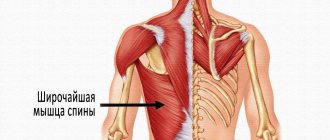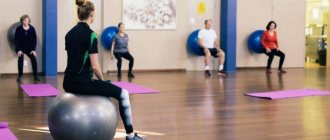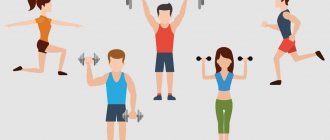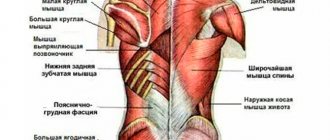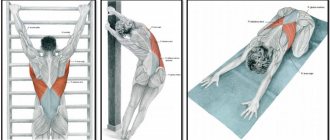Causes and symptoms of SCH
Causes
- Carrying a bag on one shoulder or in one hand.
- Incorrect posture while sitting.
- Using a pillow that is too high.
- Additional risk factors.
- Physical inactivity.
- Excess weight.
- Injuries of the cervicothoracic spine.
Symptoms
The disease cannot be characterized by a specific set of symptoms; this complicates the process of identifying shoch. The most common of them can be noted:
- Lack of appetite, nausea and vomiting.
- Headache.
- Loss of orientation in space, stability.
- Noise and ringing in the ears.
- Unusual redness or paleness of the face.
- Short-term visual impairment.
- Heavy sweating.
- Increased heart rate.
The benefits of physical education
The main tasks that the doctor and the patient set themselves:
- prevention or disappearance of the inflammatory process;
- restoration of normal blood circulation;
- the formation of intervertebral discs in their original position.
Exercises for cervicothoracic spinal osteochondrosis help to cope with these tasks.
Sport against illness
Physical exercises are important at the onset of the disease ; they can reduce or completely stop pain.
The positive effect of physical therapy is achieved through properly selected loads, which help restore normal muscle tone and intervertebral discs. This reduces the pressure of the intervertebral discs on the nerve endings.
Contraindications and side effects
Contraindications to exercise therapy for cervical osteochondrosis include:
- Bad feeling.
- Impaired cerebral blood flow.
- Acute pain in the neck and shoulders.
- Muscle compression, spasms (how to relieve muscle spasm during SCH?).
- Hernia.
- Inflammatory diseases.
- Ankylosing spondylitis.
- Cervical osteochondrosis of the 3rd degree.
- Spondylopathy.
What loads can cause harm?
Despite all the advantages of therapeutic exercises, it is worth noting those exercises that can harm the patient , further worsen his condition and increase pain.
Such exercises include physical activity that is aimed at straightening the back.
Preparatory stage
Before performing an intense workout, the body needs to be prepared.
Important Tips
- Physical therapy should be performed to relieve pain.
- You need to perform the exercises in a constant development gradually, increasing the load.
- Do not overstrain your neck by performing exercises for a long time.
Basic execution rules
- The most important thing in doing exercises is breathing.
If during training your heart rate and respiratory rate increase, then you need to slow down the pace and reduce the number of repetitions. - All classes are conducted during remission.
- After the first lessons, you should pay attention to whether problems have appeared in performing movements and whether tension and pain in the neck have increased. If this happens, then the number of repetitions should be reduced.
- In order for classes to bring results, you need to hold your back correctly during classes.
- In the first 2-3 weeks, classes should be carried out once or 2 times a day. After this, gymnastics are performed to maintain shape 3 times a week.
Exercise for hands
Do not forget to periodically rest your hands while working. An excellent solution would be to purchase a special rubber massager, but if you don’t have one, you can do the following exercise. Interlock your fingers and twist your closed palms slightly clockwise and counterclockwise to stretch your hands. Then stretch them out in front of you parallel to the floor and “turn” your palms away from you. Stretch your arms a little, slightly arching your fingers. Repeat the exercise several times.
Photo: Unsplash.com
Exercises for the upper spine at home
When performing a set of gymnastic exercises for SHO, you should not make jerks so as not to get injured. The number of repetitions is from 10 to 20.
All exercises should be performed standing, while looking forward.
- Tilt your head back. The jaw and chin should not move. You should remain in this position for 3–5 seconds.
- Tilt your head to the right and left, while your ear should reach your shoulder. You can help yourself with one hand. You should remain in this position for 3–5 seconds.
- Tilt your head forward, chin touching your collarbone. You should remain in this position for 3–5 seconds.
- Tilt your head alternately forward and back. You should remain in this position for 3–5 seconds. Do the same with turning your head to the right and left.
Gymnastics for the eyes, exercises for sedentary work and rest when working at the computer
This material is a continuation of the article about proper computer work, viewed by our readers more than 10,000 times!
You can often hear from users who spend a long time in front of a monitor: “I’m tired of the computer.” And this is actually true, since the body experiences significant stress from the effects of PC.
There are even some occupational diseases that are most often found among office workers and freelancers - constant static load on the spine and tension in the back muscles can lead to various ailments, which can only be gotten rid of with the help of doctors.
My eyes are tired from the computer: what to do?
High load on the visual system and prolonged exposure to electromagnetic radiation, as well as high stress on the psyche as a result of exposure to computer games, can cause serious diseases that are easier to prevent in advance.
Ergohuman experts' opinion:
Timely prevention will help avoid overwork when working at the computer. Scientists recommend using the “short distance” method and organizing work so that you can definitely take minutes and even hours of rest when working on projects.
As for gamers, it is important for them to independently control their daily gaming time and set limits.
It is important to spend at least one day a week completely without immersion in the virtual world - this will become a kind of mental relief and will help to avoid many neurological diseases.
Gymnastics for the eyes when working at the computer
In order to avoid computer eye pain, it is important to follow three standard rules :
- Take a mandatory break between work (it is advisable to free up time for rest every 30 minutes).
- Do complex eye exercises using any chosen method.
- Adjust your monitor to create optimal screen brightness. The contrast also needs to be adjusted so that the eyes are as comfortable as possible.
As for the special warm-up for the eyes, it must be repeated as often as possible. The simplest exercise is the following: look into the distance, fix your gaze on some distant object, and then look sharply at a nearby object and also hold your gaze. This will help relieve intense stress and significantly relieve tension in the eye muscles.
Systematic implementation of eye exercises when working at a computer will help to avoid such occupational diseases of computer scientists as myopia and significant weakening of vision.
Eye training must be done regularly - during rest breaks it is important not to forget about eye exercises, but here it is important to maintain moderation.
A short series of 5 exercises will be enough:
- You need to close your eyes tightly for about 3 seconds, then open them and not blink for 3 seconds. The exercise must be repeated 5 times.
- Rapid blinking for 1 minute.
- It is necessary to close your eyes and perform a kind of massage of the eyelids - for 30 seconds you need to massage the eyelids in a circular motion clockwise with your index fingers.
- Consistently alternate looking at close and distant objects.
- In conclusion, be sure to repeat the eyelid massage with your index fingers.
If there is no time for exercise, a very short warm-up will help . It is necessary to close your eyes and make a rotational movement with your eyes several times in one direction and the other.
A set of exercises to relieve fatigue at the computer during sedentary work
Here we will tell you more about gymnastics while working at the computer for many hours. A sedentary lifestyle is an indispensable companion for those for whom a computer desk is their workplace, as well as for those who love Internet surfing and games.
Even if a person is professionally involved in sports, while sitting at the computer for a long time, it is important to do at least short warm-ups, because lack of movement for several hours will definitely affect the body. In addition, warming up will help keep your physical shape in good shape and your mood high.
Neck exercises at the computer
Warming up for the neck is mandatory - it is important to do standard exercises during short breaks. The movements can be performed standing near the desktop, as well as sitting - but it is important to keep your back perfectly straight. It is necessary to perform slow circular movements with your head clockwise and then in the opposite direction.
Next, you should tilt left and right. The head must be tilted slowly - 10 times in each direction. Bends forward and back will also help to relieve the neck well - this exercise must be performed smoothly and carefully. When performing exercises, your back must be equal - your shoulders are in place.
Exercises for arms, shoulders and legs at the computer
Warm-up for the arms is the next stage of the exercises. It is necessary to perform slow circular movements with the hand , while the arms must be extended forward.
Warming up the wrist is done by clenching your fists and rotating them in different directions. Next, you need to stretch out your arms and quickly clench and unclench your fingers with force.
This will allow you to stretch your arms well and prevent fatigue.
Warm-up for the shoulders is carried out using circular movements. All of them are performed standing - the back must be straight.
It is necessary to slowly and smoothly describe circles with your shoulders - forward, then back. The exercise can be repeated several times.
A useful exercise for relieving tension in the shoulders is to smoothly raise and lower them - you need to shrug your shoulders, raising them up and slowly lowering them.
You can do a leg warm-up even while sitting at the computer. You need to slowly tap your toes on the floor, and then do the same with your heels. This exercise is repeated several times.
It is necessary to move the foot slowly - first place it on the outside, and then on the inside.
A good exercise would be a walk in the fresh air - almost all office workers whose work includes a lunch break can do this exercise, and even more so freelancers.
Rest while working at the computer
The short sleep method began to be practiced among office workers relatively recently - psychologists even gave it the name “ Stirlitz method .” The essence of such sleep is a short rest, in which sleep lasts only 15-20 minutes. We are talking about daytime sleep in between working at the computer.
The nighttime sleep schedule must be observed - you need to get the standard 8 hours of sleep, but not less than 6. At the same time, six hours of sleep must alternate with a good night’s sleep - if you constantly feel a lack of sleep, the body receives a significant load and can weaken in a short time.
A short nap will be a real salvation for the body when you are very tired. It will allow you to rest and recover a little - it is important to set a timer for 15-20 minutes and try to escape from all your thoughts and take a nap. The body will not be able to get enough sleep in such a short period of time, but the general condition will improve significantly.
Ergohuman expert opinion
Giving your brain a rest period of 20 minutes and taking a short nap will greatly improve your mental productivity. The body receives additional energy, and many processes are significantly improved.
Over time, you can learn the technique of complete immersion - when you can get some sleep even for 20 minutes. The benefits of short sleep will be maximum. A short nap during the day will improve your concentration and prevent further fatigue.
Scientists have conducted many experiments that have proven that short-term sleep is beneficial for people engaged in both mental and physical activity.
Source: https://ergohuman.su/ergo-blog/gimnastika-i-otdyh-za-komputerom
Gymnastics for the cervical region
Simple complex
Starting position: sit on a chair, straighten your back, keep your head straight.
- Head turns . Smoothly turn your head to the right and left, stopping in each position for about 2 seconds. The number of turns is 5-10.
- Head tilts . Lower your head down as far as possible, then slowly return to the starting position. The number of inclinations is 10-12.
- Hiding the chin . Tuck your chin in while moving your neck back. The number of retractions is 5-7.
- Shoulders up . Raise your shoulders as high as possible, stay in this position for 10 seconds, lower your shoulders. The number of approaches is 10-12.
- Back of the head . Stretch the back of your head with your fingertips. The movements should be intense, but not painful.
- Bends with resistance: Starting position – sit at the table, straighten your back, keep your head straight.
- Place your elbow on the table and hold your temple with the palm of this hand.
- Tilt your head, offering slight resistance with your hand. The number of inclinations is 10-12. After that, change hands.
- Place your palm on your forehead and tilt your head, offering slight resistance with your hand. The number of inclinations is 10-12. After that, change hands.
Isometric exercise
Isometric exercises are performed in a standing position . The number of repetitions is from 3 to 5. You need to stay in each position for 10 seconds.
- Alternately bend and straighten your neck, tilt your head first back and then forward.
- Tilt your head to the right and left. The ear should touch the shoulder.
- Turn your head right and left.
- Move your neck as if plunging into water (make a wave-like movement down and forward).
- Alternately move your head forward and back.
- Pull your neck into your shoulders, then lengthen it.
Treatment of the cervicothoracic region
Typically, when conducting physical therapy, the starting position is lying on your back or side. The exercises themselves are performed slowly, gradually increasing the range of movements. If pain occurs or increases, all activities should be stopped.
- As you inhale, raise your arms up, spreading them slightly to the sides. As you inhale, connect your fingers at the top point and lower your arms down. The neck should be motionless.
- Draw arcs back and forth with the shoulders.
- Stretch your neck, stretching it forward a little.
- Draw an arc with your chin from the point of inclination to the chest to the shoulder and back. Do the same in the other direction.
- Simultaneously lower and raise your shoulder so that they meet halfway.
- Place your hands on your waist, head looking straight. The chin moves in a horizontal arc from the center, passing over the shoulder slightly back.
Exercises for the back and neck during sedentary work - gymnastics at the computer
(4 5,00 of 5) Loading...
Many professions that require absolutely no stress on the body lead to many negative consequences , for example, poor posture, poor vision, excess weight , and all these joys appear only from a lack of physical exercise at work.
In addition, a monotonous sitting posture disrupts the blood supply to the brain, which causes headaches, premature fatigue, poor memory, and impaired blood pressure. Failures in the functioning of the cardiovascular system are also a popular office ailment.
Do not forget about your susceptibility to rapid obesity , since when sitting on a chair, the pressure on the lower part of the body increases, which stimulates the accumulation of fat in it. In continuation of the fascinating study of the unpleasant consequences of sedentary work, we can mention the appearance of muscle pain, weakness, constipation, diabetes and hemorrhoids.
Exercises for sedentary work at the computer
Simple and effective exercises for the back during sedentary work will help to avoid all of the problems listed above, as well as relieve muscle tension.
Doing them will help fill your body with energy and strength for the whole day, especially considering that even a small amount of daily physical activity is already beneficial for the body.
Before listing all the effective exercises for sedentary work, it is important to note the need for morning exercises , which should last about 5 minutes, which is enough to prepare the body for everyday work.
Correct posture must be maintained at all times. To achieve and maintain it, it is recommended to choose the right chair with a hard seat, the height of which corresponds to the height of the shin, the back exactly follows the curve of the spine.
The shoulder blades should be brought together, the stomach should be relaxed, and the shoulders should not sag.
It is not recommended to lean your elbows, as this is a sure way to incorrect posture and subsequent diseases, which also leads to the habit of crossing your legs.
A set of exercises for exercise at work
Finding the body in a constant unnatural and disturbed position has a bad effect on well-being and health, leading to pain, poor concentration, blood stagnation and subsequent formation of blood clots.
To eliminate them, exercises during sedentary work are successfully used..
They incorporate gymnastics for sedentary work for most parts of the body, they are unpretentious and simple, they can be easily performed at the workplace, since they require little time, and the result is difficult to overestimate, given that only a chair is required for the exercises .
Exercises to prevent hemorrhoids
Back exercises at work
- sitting on a chair, hands are joined in a lock behind the back, shoulder blades are brought together, arms are pulled back. Good posture will be useful for this, because the straighter your back, the easier it will be to join your hands, but if you can’t do this, you can take a pencil in them. Feel the muscles stretch. Exercise improves blood circulation in the back muscles ;
- hands are joined in a lock in front of you and extended forward. The head looks down, the stomach is drawn in, and as you exhale, the arms are extended forward as much as possible. The upper back stretches wonderfully ;
- The exercise is also performed while sitting on a chair. Feet are placed wide, hands rest on hips. Then alternate turns of the body to the sides are performed with a slight delay. This way you will stretch the muscles of the middle back and lower back.
Perform each exercise for as long as you need. Feel muscle relaxation and a pleasant tingling sensation.
If you feel relief, you can complete the exercise.
The need to maintain intervals between work and rest, which should be no more than 3 hours, deserves attention.
Spinal stretching exercises at work are extremely important, since it takes on the lion's share of the load. There are many of them and they vary depending on the situation and opportunities at work.
You can always set aside some time to complete them, even if your work schedule is very busy. If you have the opportunity to watch videos at work and do a set of exercises to exercise at work based on them, it will be even better. Use the video from this article.
Those interested can see how to do fun exercises at work.
Exercises for the abs
During sedentary work, the abdominal muscles weaken , which is fraught with both a deterioration in overall appearance and the occurrence of various diseases, therefore, for women, exercises during sedentary work are especially important, because they look after their figure more than men. For preventive purposes, it is necessary to do abdominal exercises at work as often as possible throughout the day:
- Sitting. The abdomen is retracted for 5 seconds , then returns to its original position. At first, 10 repetitions are enough, but gradually their number and execution time increases. Of course, this is the main abdominal exercise at work , using all the abdominal muscles;
- Sitting on a chair. The body is tilted left and right . When performing, the back remains straight, arms are lowered. When you exhale, the body lowers, and when you inhale, it returns to the starting position. To begin with, 10 repetitions are enough, over time it is advisable to increase their number;
- Sitting or standing. The abdominal muscles are held in static tension for 5 seconds , after which they relax. You can also gradually increase the duration of the abdominal tension.
Do the first exercise wherever you can - in transport, at the computer, on the sofa. For as long as you can. And you are guaranteed an iron press! The main thing is to remember this
Source: https://www.fitnessera.ru/effektivnye-uprazhneniya-pri-sidyachej-rabote.html
Breast complex
Breathing exercises
Breathing exercises help improve blood supply and oxygen saturation of the spine.
Cat and camel
- Starting position - go down on all fours, keep your head straight.
- Smoothly bend your back to the maximum amplitude, hold in this position for 10 seconds.
- Go to the starting position.
- Also smoothly arch your back upward, creating a camel hump, and hold in this position for 10 seconds.
- Return to original position.
This set of exercises should be performed 5-7 repetitions.
Finger exercise
This exercise will not only give you the necessary respite, but will also help you develop your typing speed. Place your hands palms down on the table. Simultaneously lift up one finger of both hands (the remaining fingers should not leave the surface), then lower and move on to the next pair, gradually increasing the speed. If you get lost and accidentally raise the wrong finger, start the exercise again. Do this exercise for about a minute, then clench and unclench your fists several times to allow your fingers to relax.
Bubnovsky's technique
- Take a comfortable position - sitting.
- Slowly lower your head to the right and left, bringing your ear closer to your shoulder. You should hold each position for a few seconds.
- Lower your head onto your chest, slightly pulling your neck forward and slightly up.
- Tilt your head back a little, your back should be straight. Perform turns left and right, repeat the same with raising your arms above your head and touching your fingers.
- Place your left hand on your right shoulder, with your elbow in front. Turn your head to the left and stay in this position for a few seconds.
- Place your hands on your knees, straightening them, and moving them back, this will engage the thoracic region. At the same time, move your neck up and forward.
- Stand on your feet, tilt your head forward and describe an arc from shoulder to shoulder.
We invite you to watch a video about Dr. Bubnovsky’s method for osteochondrosis:
Computer neck syndrome. How to cure?
Computer neck syndrome is a change in the position of the head and neck as a result of the habit of reaching for gadgets. The head moves forward, as a result, the load on the cervical vertebrae increases several times.
The fact is that in a normal position the load on the neck is 4-5 kg, that is, the average weight of an adult’s head, but when we move our head forward and down, the load can increase 5 times! Muscles get spasmed, which leads to chronic neck and back pain, as many of us stare at smartphones and laptops for many hours every day.
Surgeons call computer neck syndrome practically epidemic, but first of all it affects those who sit a lot at the computer: office workers, inactive students.
Symptoms of Computer Neck
- pain in the neck, shoulders and upper back
- frequent headaches, pain at the base of the skull
- loss of vision
- feeling as if the neck is being pushed forward
- desire to straighten up, but inability to hold this position for long
What happens to the body
If you don't control your posture while sitting at a computer or looking at a smartphone, the body adapts as best it can on its own.
Poor posture leads to muscle imbalances: the upper back, shoulder, pectoral muscles, and back of the neck become spasmed and shortened, while the mid-back muscles and front of the neck become weakened and stretched.
If the problem is not solved, stooping leads to a deepening of the lumbar deflection and, as a result, a “dumping” belly.
Incorrect back position becomes habitual and develops into a chronic position, causing stooping.
Tight muscles compress nerves and blood vessels leading to the brain, which causes headaches and fatigue. For the same reasons, vision problems may occur.
A weakened front surface of the neck leads to sagging skin and often to the appearance of a double chin.
In some cases, if nothing is done, computer neck syndrome can cause degenerative processes in the intervertebral discs and arthritis. Then simple exercises and changing habits will no longer help: medication or even surgical intervention may be necessary.
So it is better to prevent or nip this common problem in the bud.
7 exercises for treatment and prevention
Perform this small complex daily in the morning or evening. It will be useful to do certain exercises several times during the day as a warm-up. If you practice at home, it is better to do it while sitting on the floor on a mat. But sitting on a chair is also possible, although not as comfortable - this option is suitable for the office.
Shaking your head
- Sit on the mat with your legs crossed.
- Pull your shoulders back and down, open your chest and lengthen your neck.
- Bend your head forward, without changing the position of your back, bring your chin to your chest.
- Start slowly and gently shaking your head left and right, drawing small arcs.
- Gradually increase the amplitude.
Semicircles with your head
- Continue performing the previous exercise, increasing the amplitude until each ear reaches the same plane as the shoulder of the same name.
- At this stage, you should already feel a good stretch in the back and sides of your neck.
- Make sure that your shoulders do not rise, pull them back and down.
Circles with your head
- After completing several semicircles from side to side, continue moving until you complete a full circle.
- Do not throw your head back too far: focus on stretching your chin toward the ceiling rather than bringing the back of your head closer to your back. This is important because otherwise the vertebrae can be damaged.
- Perform 4-6 circles, then the same amount in the other direction.
Shoulder rotation
- As you inhale, bring your shoulders forward, then up.
- As you exhale, pull back and lower.
- Feel how the muscles of your upper back pleasantly relax as you exhale.
- Make 6-8 of these shoulder circles.
Shrug
- Relax your arms in front of you or place your palms on your knees.
- Make sure your back is straight. If necessary, move your shoulders back and down.
- As you inhale, forcefully pull your shoulders towards your ears, hold for a second in a tense state.
- As you exhale, relax your shoulders, sharply “throwing” them down.
- Repeat 4-6 times.
Let's hug ourselves
Now we cover an even wider area: stretch and relax the area between the shoulder blades and the upper back as a whole.
- Inhale and spread your arms to the sides, squeezing your shoulder blades and opening your chest.
- As you exhale, round your back, draw in your stomach, tuck your chin to your chest and hug yourself, crossing your arms and placing your palms on opposite shoulder blades.
- Stay in this position for a few seconds.
- With an inhalation, spread your arms again and with an exhalation, hug yourself, now crossing your arms in reverse: if before the right one was on top, now let the left one be.
- Perform 8-10 times, alternating hands.
Incline
And finally, let's stretch the entire back.
- Inhale and stretch upward, raising your arms to your sides.
- As you exhale, bend forward and lower your palms to the floor in front of you as far as possible.
- Relax your neck and let your head drop. Let your neck stretch gently under the weight of your head.
- Stay in this position for 30-45 seconds, trying to gradually deepen the pose.
- Inhale and walk your palms back towards you.
Changing movement habits
Even regular exercise, unfortunately, is not enough to solve the problem. After all, we perform them for a total of only an hour and a half a week, and the rest of the time we train our body to remain in a completely different, incorrect state.
Therefore, without changing the usual way of sitting and moving, nothing will happen. The key to solving the problem is simple and complex at the same time.
- So, freeze and feel the position of your head and neck now. Tense and forward?
- There is no need to sharply withdraw your shoulders and round your chest: you will only last a few minutes in this tense position.
- Instead, focus your attention on the back of your neck and relax it.
- You will feel how your head “moves” back by itself, falling into place, and your shoulders relax and fall. Magic!
What's so difficult about this? And the fact that muscle memory is an extremely stubborn thing. You took a new position, were delighted with the effect, and then returned to business - and within a few minutes your body returned to its usual position.
It takes time and regular, repeated repetitions for muscle memory to be “overwritten.”
Therefore, it is important to remember the need to relax the back of the neck many times a day, constantly. You can even set yourself an alarm clock that will remind you about your posture every half hour. To avoid disturbing others, you can set it to vibrate.
Yes, it looks complicated and dreary, but believe me: if every 20-30 minutes you persistently return your head to the desired position, the effect will become noticeable within a few days. Monitoring the position of your head will first become a habit and stop straining, and then muscle memory will be rebuilt .
There is also this nuance: by relaxing the back surface of your neck, you will feel how the front surface immediately tenses.
That's right: remember, at the beginning of the article we said that due to muscle imbalance, the anterior muscles of the neck lose tone and become stretched? Now they have again had to take on the assigned load, but at first it will be unusual for them. After a few days of practice, the muscles will partially adapt and you will not experience such discomfort.
Strengthening exercises will accelerate the formation of a normal muscle frame in the neck:
- Lie on the mat on your back.
- Place your palm under your head and then remove it, leaving your head at the same level. That is, there should be a gap of a couple of centimeters between the head and the floor.
- The arms are extended along the body.
Only the front surface of the neck works. - Stay in this position for 20-30 seconds, then gently lower your head. If the muscles begin to experience severe discomfort earlier, stop early. After a couple of days, increase the duration.
Do 3 sets.
- Now bend your knees and turn onto your right side.
- Place your right palm under your head. Get it. Feel the left side of your neck tense.
Do 3 sets of 20-30 seconds and perform the exercise on the other side.
Additional treatment and prevention
Yoga
You need to start gradually. Do yoga for the spine about once a week for about half a month . If no pain occurs, you can increase the number of classes to 2 times a week. There are many exercises that are indicated for cervical osteochondrosis.
- Utthita Trikonasana.
- Parivritta Trikonasana.
- Vrksasana.
- Virabhadrasana I and II.
- Ardha Chandrasana and others.
You will learn how to perform these and other exercises, as well as indications and contraindications for SHOC here.
We invite you to watch a video about yoga for osteochondrosis:
Pool
Swimming can reduce stress on the spine . The positive effect of procedures in water is achieved within 40 minutes, during which time the intervertebral discs return to their places.
How to move in water?
- Go into the water up to your chest and walk in place, raising your legs higher and actively moving your arms.
- Raise your bent leg so that your knee reaches your stomach. Repeat the exercise 10 times.
- Go into the water up to your neck and spread your straight arms to the sides and lower them. Repeat the exercise 10 times.
- Place your hands on your belt. Gently arch your torso, trying to keep your shoulder blades connected together. Then round your back. Repeat the exercise 10 times.
- Leave your hands on your belt, slightly twisting your torso to the sides.
Repeat the set of exercises 3 times.
Running and fitball
Running is indicated for patients whose disease has just begun to develop. Before jogging, you should walk a little and warm up thoroughly. You need to jog.
Exercises with a fitball are suitable for rehabilitation of the thoracic and cervical regions.
Exercises with fitball
Fitball exercises help:
- tone muscles;
- improve joint mobility;
- spine stretching.
The main advantage of the exercises is that they are suitable for people with different physical fitness. The fitball is selected individually depending on the height and weight of the patient.
Horizontal bar and exercise equipment
What to do on the horizontal bar?
Exercises on the tourniquet help to stretch the spine and eliminate compression of the nerve roots. It is important to understand that with cervical osteochondrosis, these exercises can provoke a deterioration in the patient’s condition and affect the reduction of blood supply to the brain. This is due to the fact that performing a hang or half-hang leads to pinching of the fifth cervical vertebra.
Therefore, you should hang on the horizontal bar upside down, clasping the bar with your legs.
If the leg muscles are not ready for such loads, you can use safety belts. After some time, the exercises can be performed with dumbbells and turning the body to the right and left.
Use of simulators
Classes can be carried out both in the gym and at home. To treat cervical osteochondrosis, you can use various exercise machines.
- The expander develops the muscles of the arms, forearms, muscles in the thoracic and cervical region. It is a flat or tubular harness with two comfortable handles, which can be mounted on the wall or performed exercises by standing in the middle of the harness.
- Cardio equipment includes an orbitec, a treadmill and a manual rowing machine. Exercises are carried out 2-3 times a week for 30-60 minutes. Such exercises promote weight loss and improve the functioning of the cardiovascular and nervous systems.
- The Evminov simulator is designed specifically for the prevention, correction and treatment of osteochondrosis in the thoracic and cervical region. It is a wooden panel equipped with movable handles.
- The Yalovitsyn swing is designed to stretch the spine. It is a wooden structure, similar to a children's swing at the ready.
Often, a gymnastic stick is used as equipment when performing exercises for the back and neck with osteochondrosis. You can read more about this here.
Indications and preparation for training
A sedentary lifestyle can lead to the development of scoliosis, kyphosis, osteochondrosis and other spinal diseases. The first signs of osteochondrosis are increasingly common even at the age of 30, and by the age of 50 the disease reaches an advanced stage as a result of associated complications.
As osteochondrosis progresses, disc protrusion or rupture of the fibrous ring occurs, resulting in an intervertebral hernia, which can only be removed surgically. Instability of the spinal regions leads to pain and limited mobility of the affected parts of the body.
Exercises for the spine and neck
A person has 33 vertebrae, held together by ligaments and intervertebral cartilage (discs). By performing a set of exercises, each person can increase their own flexibility and strengthen the muscular framework that protects the spinal column.
A correctly selected complex allows you to avoid surgery in the event of the onset of the disease. Often, it is with the help of exercises that you can completely forget about an unpleasant diagnosis and avoid the risk of ending up in a wheelchair.
Complexes for the formation of a flexible and reliable muscle corset around the spinal column require preliminary warming up of the body and warm-up.
With excessively sudden movements with a strong amplitude, the connections of individual vertebrae can be disrupted. Often injuries lead to damage to the intervertebral discs or pinching of the nerve endings passing inside. For this reason, before starting the exercises, preparation for training is necessary. You need to start with a small warm-up.
This may include:
- bending to the side;
- bending forward;
- back bend;
- tilting the head back and forth, left and right;
- circular movements of the head.
To prepare for further active exercise, warm up the muscles, and ensure blood flow, it is enough to do each exercise 10-15 times. Two approaches can be taken.
Such exercises are equally indicated for completely healthy people for the prevention of possible diseases and for those who already suffer from osteochondrosis.
Experts' opinion
Doctors advise against sleeping on large pillows; it is advisable to use an orthopedic cushion. After treatment of the acute form, it is recommended to visit the bathhouse and sauna, and sign up for the pool.
You also need to avoid hypothermia. Under no circumstances should you self-medicate ; the transition from one stage to another occurs very quickly.
What does Doctor Shishonin say?
According to Dr. Shishonin, simple exercises can cope with various problems, improve well-being and restore tone to the neck muscles. Dr. Shishonin has developed a set of exercises aimed at treating and preventing both cervical osteochondrosis and other neck problems. You can learn about the features of performing Dr. Shishonin’s gymnastics with SHOC from our material.
We invite you to watch a video containing Dr. Shishonin’s opinion on osteochondrosis:
We also recommend that you familiarize yourself with the principle of action of gymnastics by Alexandra Bonina and Vladimir Butrimov for cervical osteochondrosis.
Developments of Dr. Frolov
Dr. Frolov developed a health course: “Warm-up for the spine,” which has helped many people cope with spinal diseases. The doctor has a special complex that will help avoid surgical intervention for intervertebral hernias. Watch the video:
Dear friends, you have seen that a simple warm-up for the back helps people remain able-bodied, mobile and healthy. Perform any of the complexes daily to avoid problems with the spine.
When and what results can I expect from physical education?
Proper and regular exercise therapy will help you cope with pain and recover from osteochondrosis within 4-6 weeks. In severe forms of the disease, a quick effect cannot be achieved; you may have to undergo treatment for 6-12 months.
Regular exercises for the back and neck will not cure osteochondrosis completely, but it will help to significantly improve the condition, remove tension and pain, and stop the development of the disease. A set of training can only be performed in the remission stage.
Exercises for the head and neck
This gymnastics complex was developed specifically for those people whose work involves constantly being at the computer. To perform these exercises for the head and neck you will only need a couple of minutes. As a result, you will relieve tension, increase concentration, and improve performance, while eliminating muscle pain and headaches. So, let's look at the most effective exercises for the head and neck.
